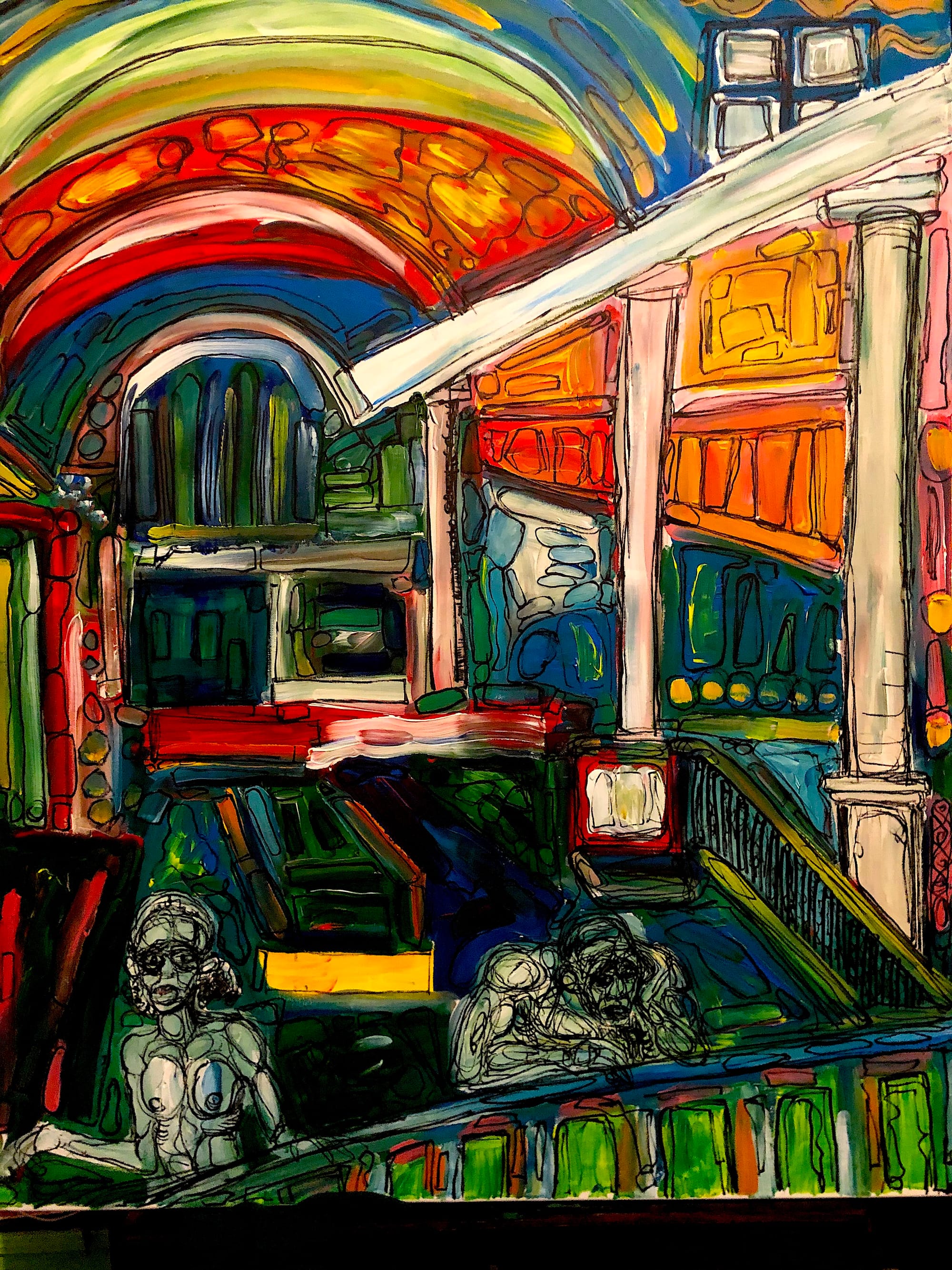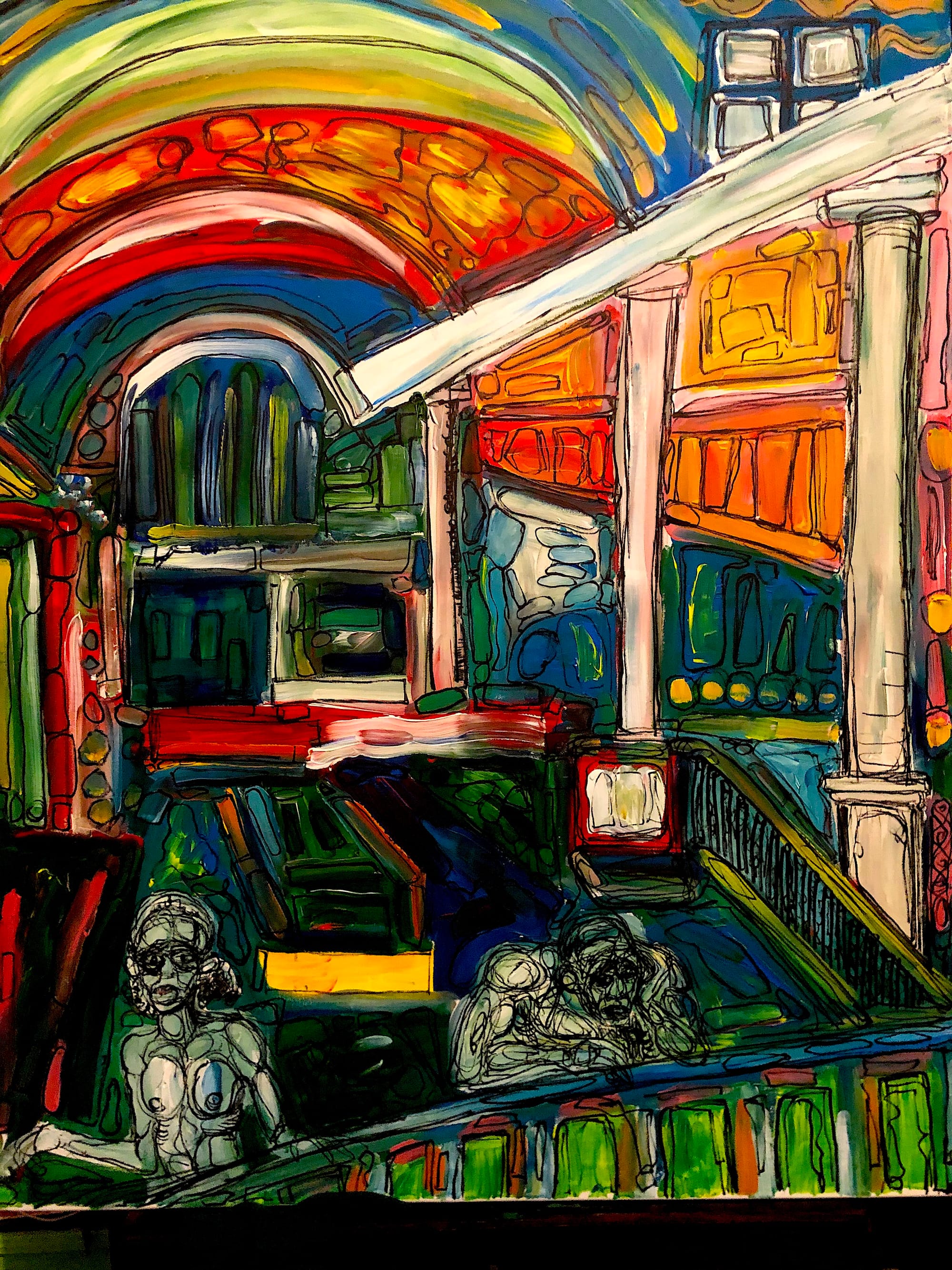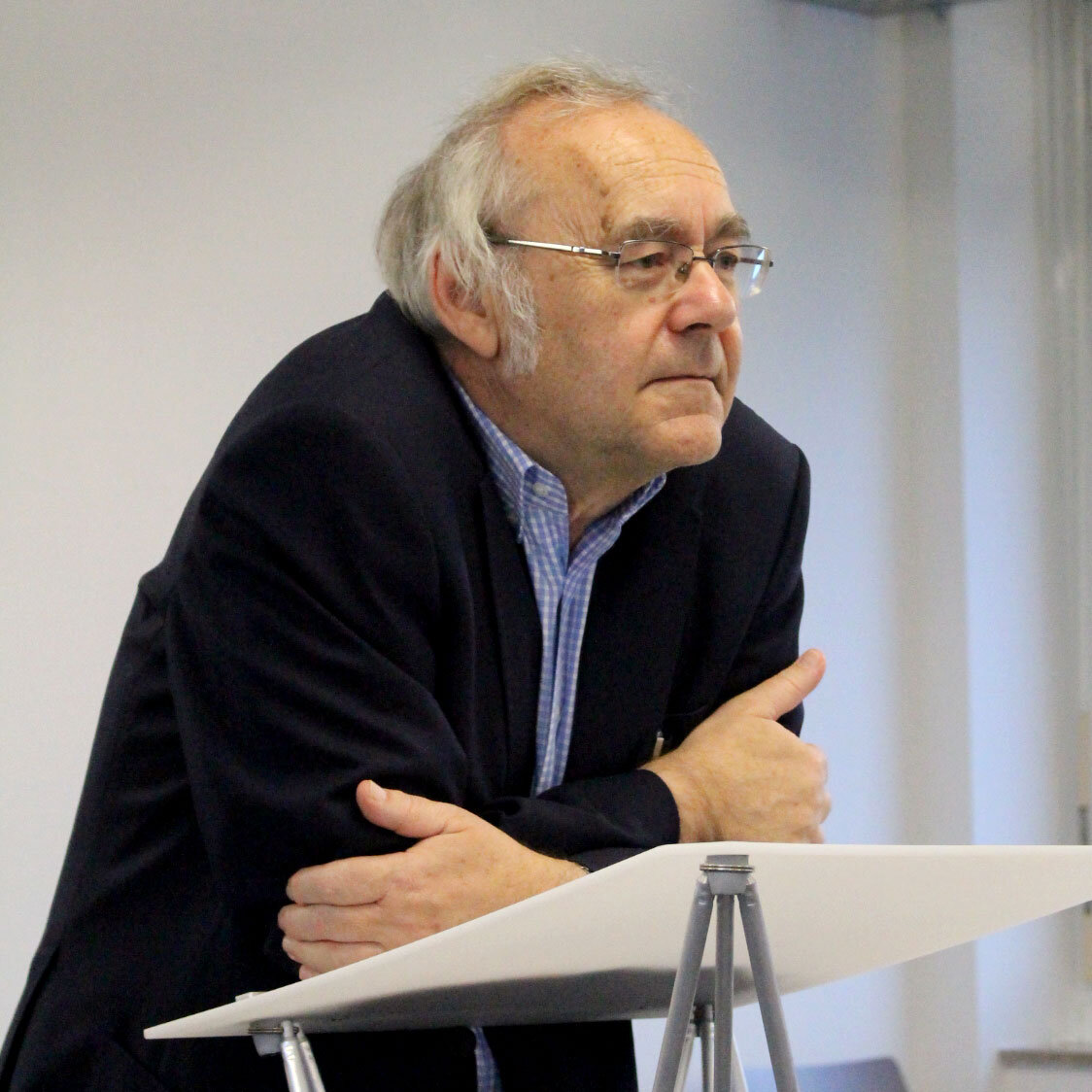The Beyond of Philosophy 7


39. New, additional descriptions cannot be tested against the descriptions so far. They form together with the descriptions so far, together with the object they describe, a new object of a new description. After the description of the table standing in the corner by A: “The table standing in the corner is round.” the object of a new, further description is the table standing in the corner that is round. After the description of B: “The table standing in the corner is square” the object of a new further description is the table standing in the corner that is square.
40. A decision cannot be achieved by returning to (a) previous common description(s) – the common starting basis – but, if at all, through proceeding to further descriptions (and those could be introduced by a third party), which are approved by A as well as B and are either compatible with the table standing in the corner being round or with the table standing in the corner being square or with the table standing in the corner and yet differently shaped.
41. Dualizing Speech transforms the neutralistic starting basis into an at least relatively neutral basis of reference. Accordingly in our example A and B presuppose the table standing in the corner to their descriptions of the table standing in the corner as a common and ‘language-distinct’ object. The descriptions are referred to the object and directed towards the object.This procedure has a chance of success (which would amount to an elimination of inadequate and failing descriptions) only, if the ‘language-distinctly’ presupposed object has all those attributes, which it is then ascribed in the best case, namely in the case of truth, already prior to this ascription.
42. Depending on the theory of truth put forward various tests and investigations are used to determine whether truth is the case or not.But independent of this – that is: already before the investigations – A and B label their respective descriptions as ‘true’, ‘adequate’ or ‘correct’ or at least as ‘more (likely) true’, ‘more adequate’, ‘more correct’ – in any case they give preference to their own description against a deviating description of the other discourse-participant.
Namely as long as it is considered that labelling descriptions, statements etc. as ‘true’ (or ‘more likely true’) makes sense, this accolade can only be attributed and awarded to the own description or statement.
As soon as we get to know a description held to be truer or more likely true than our own description, we are going to hold this description and not the - then no longer - “own” description. (Except we play advocatus diabioli and lie, that is talk differently from how we think.)
That we accord to our own descriptions, as long as a concept of truth is employed, a better chance of truth than to all deviating descriptions known to us, does of course not exclude that for example a chemist knows more about chemistry than we do, that our knowledge about chemistry is shaky and probably false, but we can not claim that it is lesser, more shaky, more likely false than our known knowledge about chemistry, that is, than the knowledge about chemistry we know of and which we therefore have available.
43. To label a sentence as ‘true’ only makes sense, if that what makes the sentence true is assumed to be given before the labelling as ‘true’; when the truth-conditions are presupposed as already being satisfied – when for example the object is already so as is then claimed in the – therefore – true statement, when that group of statements is already there with which the – therefore – true statement agrees, when the scientific community already holds the views with which the – therefore – true view is cohering.
(And, depending on the version of Dualizing Speech practiced, we could, instead of ‘true’, choose expressions like ‘approximate truth’ or ‘verisimilitude’ or similar.)
44. So A and B label in conformity with the Dualizing Speech their own description as true and the contradicting description of the discourse-partner as false.
Now, after the descriptions of A (“The table standing in the corner is round.”) and B (“The table standing in the corner is square.”), there is no longer the one and same object, but, resulting from the A-description, the table standing in the corner and being round or resulting from the B-description the table standing in corner and being square.
From this one should not draw the inconsequence that two tables are standing in the corner (or even in two corners), one of which is round and the other square. And likewise it does not follow that the table in the corner is round and square.
An observer would decide for one of these versions or perhaps for a third one, for example that the table is oval. (He could as well decide that there is no table but a chair standing in the corner, but then he does not even tacitly participate in this discussion.)
A neutral observer cannot decide for any one -- and as well not for an addition - of the two descriptions; he is blind, a deus ex machina of the Dualizing Mode. The table standing in the corner is either round or square.
When A or B would allow the contradiction they would drop out of the discussion or it would not even get started.
If now according to the Dualizing Mode A refers the description of B to the table standing in the corner, then this ‘reference’ works in the following way: A refers the deviating description of B to the starting basis which is misused as a reference basis. But this alone does not lead to the desired result: The starting basis is unsuitable as a decision-criterion between the two diverging descriptions, because it does not contain one of the two diverging descriptions but is compatible with both.
To reach a decision A must refer the description of B to the starting basis and the description with which he continued/altered the starting basis. Thus the common object of the descriptions of A and B (the description so far in common) does not serve any more as the object of reference but rather the object of further description(s) that has emerged from A’s description of the common starting object, namely the table standing in the corner which is round.
The attempt of A to refer the deviating description of B to the object can also be explained as the attempt to describe the object (which is no longer only the common starting object, but has already been changed/altered by his own description into the table standing in the corner and being round) so, as B has described the common starting object, namely the table standing in the corner.
The outcome of this procedure is clear: The deviating description of B is not contained in the descriptions so far of A, it contradicts them, it misses the object, does not apply to the object.
On the other hand A succeeds in referring his description ( from now on ) “The table standing in the corner is round.” to the reference-object, if this is understood as the common starting object. In this case the reference is nothing but the description that insofar changes the starting object and is therefore compatible with it. The reference is of course also successful when the object of reference is the starting object that has already been changed/altered by the description “The table standing in the corner is round.” and it is so, because the description to be referred to the object is already contained in the object.
In addition the attributes of the ‘language-distinct’ object of the descriptions can only be denoted insofar as these attributes are ascribed to the object in the descriptions.
And it is only trivial that a recourse can reach a decision for or against a description, even in the way discussed here, only insofar as the attributes of the object are denoted, to which the respective description should refer to. Otherwise a recourse to the object to secure the adequacy of descriptions would be superfluous or even impossible, because then no claims about the attributes of the object would be raised in these descriptions.
45. If we now consider that in the case of conflicting opinions we generally examine first the description we grant the lesser chance of being true – that is the description deviating from our own description – then it is obvious that this description is doomed to failure if the procedure sketched above is applied.
To make this failure binding for the one whose descriptions are concerned, it does not suffice to have the deviating description fail against the own description simply because it does not agree with it.The failure needs instead a special legitimization by making use of an arbiter/criterion/referee that is categorically distinct from the contradicting descriptions and recognized by both opponents, – here the ‘language-distinct’ same and common object of both descriptions.In other variants of Dualizing Speech for example a special privileged system of statements – like the views of the leading scientists – may serve as an arbiter.
46. The presented form of the decision procedure is albeit a simplification which at least should contradict regular scientific practice.This procedure only leads to both, A as well as B, legitimating/justifying their preconceived (and thereby already prior to the recourse given) description via the recourse.
The decision for or against descriptions is more often made through procedures which are not as simple. Such a procedure is to test the descriptions which have been discussed against the object of the descriptions with respect to their adequacy, whereby the practiced examination-procedures exceed the descriptions already performed and enable a decision that could be accepted by both opponents.
47. According to Dualizing Speech the examination (of the truth, of the adequacy) of descriptions takes places at the object. The resistance of reality (more precisely: of the examined segment of reality, that is of the object of the descriptions in question) is brought in effect through experiments.
The examination is successful when the object has been investigated whether it has the attributes ascribed to it in the descriptions ‘in reality’ as well.
In our example it shall be examined whether one of the two descriptions “The table standing in the corner is round.” and “The table standing in the corner is square.” matches the table. This examination could take place perhaps so that A and B walk up to the table and look at it closely, (or) perhaps that they glide their hand along the edge of the table to detect any corners that may be there, or that they put a divider into the centre of the tabletop, draw a circle and observe if any corners are sticking out.
If now the common test procedures reveal that the table is round, a subsequent reference of the description “The table is round.” will succeed and a reference of the description “The table standing in the corner is square.” will fail. The presence of that adequacy which allows awarding the truth-predicate (or a similar predicate) is tested in the understanding of Dualizing speech against the object of exactly those descriptions which should be awarded or denied this predicate.
48. If the idea of a ‘language-distinct’ object is renounced , the descriptions in question cannot be tested against the object.
The common object of the descriptions in question is, as the common element of both descriptions, the neutralistic starting basis which is equally compatible with both descriptions.
The coincidence/agreement (“Übereinstimmung”) needed for awarding the truth-predicate to the description “the table standing in the corner is round.”, can not only be the coincidence/agreement with the object of these descriptions, namely the table standing in the corner. Therewith the description “The table standing in the corner is square.” coincides/agrees too.
Although the examination of the descriptions does not take place at the object, it starts from the object of the descriptions.
49. The description of the table is examined through the investigation of the shape of the table, whether it is round, square or else. The shape of the table can only be investigated, as long as is not investigated if there is a table standing in the corner. This must be presupposed, at least for the duration of the investigation.
(Of course it can happen that in the course of the investigation of the shape of the table results are emerging which lead to a subsequent investigation, whether a table is there or, perhaps, another piece of furniture. The starting basis can be questioned, but only after a new starting basis has been created – for example the piece of furniture standing in the corner.)
If now A and B begin to examine the descriptions by carrying out various investigations (‘close’ looking, touching the edge of the table, measuring the diagonals which A and B have drawn across the edge of the table and/or other investigations) it has to be taken into account that the descriptions-in-question also have not been ‘pulled out of thin air”.These descriptions as well have come about through different investigations of the table (resp. they present different investigations of the table.)
(If the descriptions in question had been “pulled out of thin air” by A and B, and therefore had not have emerged from an investigation, then these descriptions could not have been held to be at least more likely true than the deviating descriptions. The descriptions were not made for no reason.)
Another presupposition for a common examination – and here only such an examination is of interest to us – of the descriptions is that the investigations from which the descriptions emerge/result, must not be the only investigations that A and B are capable of. Because if A and B have already exhausted their investigative capabilities through those investigations which find their expressions in the each different and contradicting descriptions, then a (further) examination is not possible.
The investigations which determine the ‘reference-basis’ for the examination of the descriptions in question must not be a mere repetition of the investigations which were carried out to get to the descriptions-in-question of the table standing in the corner initially. In this way a common examination of the descriptions in question would be prohibited.
50. Now where is the difference to the reference-procedure discussed above (§ 37ff.)?
The descriptions in question do not refer to a basis of reference which is different for A and for B, namely one time to the object which has emerged from the A-description of the starting basis and the other time to the object which has emerged from the B-description of the starting basis. Instead the recourse is made to a common reference basis. This reference basis is the object which has emerged from the common examinations of the starting basis, whereby we want to assume here that it is the table standing in the corner and being round. Thereby the attempt of an examination of B’s description-in-question “The table standing in the corner is square.” fails. Where does this description fail? It does not fail at the object which the description has described, namely the table standing in the corner. Therewith it is compatible – this description is the meanwhile failed attempt to form together with the object a new object, namely the table which stands in the corner and is square. And it does not fail against other pre-given descriptions either. The common investigations by A and B which brought forth the table standing in the corner and being round as a (new) object (of further descriptions), were only carried out after the descriptions which were to be examined.
Thus the decision between the descriptions in question is not achieved through a recourse to descriptions already there, but through an anticipation , through a going on to further descriptions; through carrying out new descriptions which have come about in a common effort and which are compatible with the description-in-question of A and not with the description-in-question of B.
Whilst the recourse in the first case (§ 37ff.) is the attempt to eliminate the description deviating from one’s own description, it is superfluous in the examination-variant; superfluous because the decision has been made merely by the carrying out of the common investigation and the description connected with it.
Now it is of course trivial, that common investigations lead to common results. Not trivial is the attempt of Dualizing Speech (of the Dualizing Way of Speaking) to construct from the result of the investigation, that is from ‘the last/recent state of things’ a ‘language-distinct’ examination-object, a ‘language-distinct’ reference-basis.
In the first case this ‘reference-basis’ served to eliminate the description deviating from the description of A, namely the description of B, and vice versa. In the second case it can be used to make eventual new descriptions fail (which C or someone else may introduce into the discourse), that run counter to the now common description of A and B.
Dualizing Speech is based on the attempt to presuppose the result of the common investigations as a ‘language-distinct’ object in advance of the descriptions-in-question and these investigations. This is how Dualizing Speech redeems the claim that the object already has the attributes which are then ascribed to it in the therefore true description.

Josef Mitterer is an Austrian philosopher.
Next: The beyond of Philosophy 8
The Beyond of Philosophy 1 here
The Beyond of Philosophy 2 here
The Beyond of Philosophy 3 here
The Beyond of Philosophy 4 here
The Beyond of Philosophy 5 here
The Beyond of Philosophy 6 here